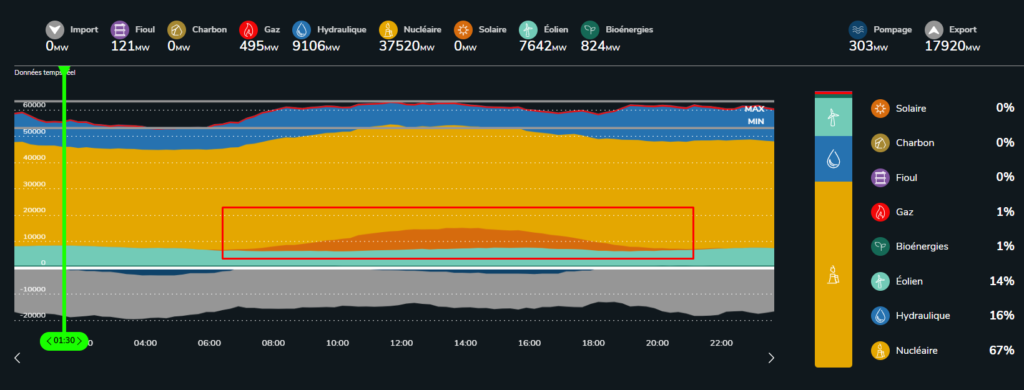The French Energy Regulatory Commission (CRE) and Enedis initiated a significant project in mid-May to re-evaluate the “peak/off-peak” electricity pricing system.
The goal is to better align this system with the evolving French electricity landscape. This project has raised numerous questions, which we will address here.
What is the Purpose of the Peak/Off-Peak System?
Electricity providers in France offer both “basic tariffs” with a constant price per kilowatt-hour (kWh) throughout the day, and “dual tariffs” with different prices for peak hours (heures pleines or HP) and off-peak hours (heures creuses or HC). Off-peak hours are typically 25-30% cheaper. Peak hours correspond to periods of high and medium demand on the electricity grid, while off-peak hours are periods of low consumption, mainly at night.
Maxence Cordiez, a member of the Connaissance des Énergies Experts Committee, explains that this system “aims to send a price signal that encourages consumers to be flexible with their demand, shifting their usage from times when supply is most constrained to times when it is not.”
The savings for consumers (estimated to occur when a customer shifts 30% of their consumption to off-peak hours) are “a form of payment for the service they provide to the network, by avoiding the start-up of expensive fossil fuel plants at certain times and avoiding the curtailment of low-carbon production at other times.”
Who Sets the Off-Peak Hours?
Peak/off-peak tariffs typically include 8 off-peak hours and 16 peak hours per day, with varying distributions. The grid operator, primarily Enedis and RTE for large industrial consumers directly connected to the transmission network, sets the off-peak hours. Enedis randomly assigns the 8 off-peak hours to new customers to avoid concentrating all consumers in the same period.
Energy providers are free to follow the grid operator’s schedule or distribute off-peak hours differently. However, following the operator’s schedule is advantageous as the “TURPE” (Tariff for the Use of Public Electricity Networks) is lower during the hours chosen by Enedis.
How Many Households Have Peak/Off-Peak Pricing?
The peak/off-peak system applies to nearly 14 million electricity meters, roughly half of French households.
Why Consider a Reform of Off-Peak Hours?
“Changes in energy usage and, above all, electricity production are altering the strain on the network. It’s therefore natural that peak/off-peak tariffs adapt to this evolution, given their role in reflecting the state of the network,” emphasizes Cordiez.
“While the network remains strained in the morning and around 7 p.m. in winter, it is traditionally less so at night due to low demand, and increasingly less so in the afternoon due to growing solar photovoltaic production. This is especially true in summer when solar PV production is at its peak.”
The primary goal of the reform is to better align demand with the increasing photovoltaic production during midday hours in summer and avoid negative price episodes in wholesale markets.

What Concrete Changes Are Expected?
The current reform proposal would maintain the principle of 8 off-peak hours and 16 peak hours. However, it would differentiate the schedules for winter and summer (in 2023, solar production in France was around 8 TWh from June to August, compared to 3.5 TWh between January and March, according to RTE).
Importantly, there is no intention to eliminate off-peak hours at night in summer, as some observers have suggested. The plan is to keep some off-peak hours at night and add some during the day (between 10 a.m. and 4 p.m., for example).
Cordiez considers this potential change “a first step”: “We could go further and have two peak hour periods and two off-peak hour periods to better reflect the state of the network. This will probably be necessary in the long run.”
When Will This Reform be Implemented?
The reform of off-peak hours is part of the broader revision of the “TURPE 7” (Tariff for the Use of Public Electricity Networks), which will take effect on August 1, 2025.
However, the timeline for the off-peak hour reform will be “very gradual,” according to the CRE, with changes likely spread over several years. A one-month public consultation starting in late September/early October will review the proposed options. Following this consultation, the CRE can provide further details on the reform, and this timeline should be known by the end of the year/early 2025.
Concerns About Consumers Being Disadvantaged
The idea is “not to make the consumer pay more, on the contrary, but to encourage them to adapt part of their consumption to production” (with a modification of tariffs to make the peak/off-peak system more advantageous), emphasizes Cordiez.
“While this change could initially seem restrictive for certain uses (charging electric cars)” if off-peak hours were removed at night in summer, this fear is fading given the actual intentions of those behind the reform. This reform will also be “advantageous for other uses with household appliances (washing machines, dishwashers, etc.) running during the day to avoid noise at night, for example,” notes Cordiez.
Source: CONNAISSANCE des ENERGIES (CDE)